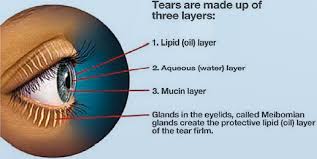DRY EYE
- Home
- Dry Eye
Tears form a very important part of our eyes. They help keep them healthy and comfortable. IF OUR EYES DOES NOT PRODUCE ENOUGH TEARS OR IT EVAPOURATES QUICKLY THEN THIS CONDITION IS KNOWN AS DRY EYE AND IT IS A COMMON CONDITION IN HUMAN. Dry eye can affect one or both eyes and it can also lead to inflammation. In simple words, the condition of Dry eyes occurs when tears evaporate too quickly or if the eyes produce extremely low tears.
Anatomy of Dry Eye
Tear Film has three major components including Mucin, Lipid and Aqueous.
- Outer Lipid- Human cornea is covered by an aqueous tear film and the outermost layer of the tear film is coated by lipids. The main function of lipid layer is to prevent the evaporation of eye.
- Middle Aqueous- The largest portion of tear film is composed of aqueous. This aqueous material contains different types and concentration of Mucins. The mucin is nothing but a sticky protein. Most of the tear film components are dissolved in this layer including oxygen supply to cornea. The Lacrimal glands are almond-shaped, paired exocrine glands. Its main function is to secrete the aqueous layer of the tear film.
- Inner Mucin- This thickest concentration of mucins is located at eye’s surface. This inner mucin helps to stabilize and spread the tear film. The mucin is produced by Goblet cells.

Keratocon Junctivitis
Dry Eye Syndrome (DES) is also known as Keratoconjunctivitis Sicca (KCS). It is a chronic, bilateral desiccation (dryness) of the conjunctiva and cornea occurring due to an insufficient tear film. KCS is a common dysfunction of eye and this condition is a common cause of ocular irritation that typically resulting grittiness, redness in eyes and blurred vision. Keratoconjunctivitis sicca is effectively manageable with modern treatments. Artificial tears and punctum plugs are used to relieve mild symptoms of Keratoconjunctivitis Sicca.
Symptoms of Dry Eye
Common symptoms of dry eye are
- Eye redness
- Blurred vision
- Burning, stinging sensation in eyes
- Stringy mucus in eyes
- Difficulty in wearing contact lenses
- Unable to drive a car at night
- Watery eyes
Causes of Dry Eye
In most of the cases, the causes of dry eyes are lower tear production or higher tear evaporation. Common Causes Of Lower Tear Production Are:
- Aging
- Side effects of certain drugs like antihistamines
- Certain medical conditions such as Sjogren’s syndrome, eye allergy, rheumatoid arthritis, lupus, scleroderma, sarcoidosis, thyroid disorders or vitamin A deficiency
- Corneal nerve desensitivity caused due to prolonged contact lens use

Common Causes of Higher Tear Evaporation are
- Posterior blepharitis
- Eye allergies
- Eyelid problems like lids turning outward (ectropion) and the lids turning inward (entropion)
- Exposure to wind, smoke or dry air
- Less blinking which can occur in certain conditions such as Parkinson’s disease or when concentrating during certain activities like reading, driving or working at a computer
- Vitamin A deficiency
Risk Factors of Dry Eye
- Aging
- Side effects of certain drugs like antihistamines
- Certain medical conditions such as Sjogren’s syndrome, eye allergy, rheumatoid arthritis, lupus, scleroderma, sarcoidosis, thyroid disorders or vitamin A deficiency
- Corneal nerve desensitivity caused due to prolonged contact lens use
Diagnosis of Dry Eye
Common tests and diagnosis procedures used to determine the cause of dry eyes include:
- A complete eye examination
- A Schirmer test to measure the volume of tears
- A tear Osmolarity test to measures composition of particles and water in the tears
- A test (use of special dyes in eyedrops) to determine the quality of tears
- Tear samples are taken to detect markers of dry eye disease like elevated matrix metalloproteinase-9

Treatment of Dry Eye
Common treatment methods include-
The treatment of dry eye condition is mainly depending on the severity of disease. For mild dry eye symptoms, doctor suggest patients to regularly use eyedrops. A main goal of treatment is to manage a condition that is causing dry eyes and to improve tear quality and stop tears from quickly draining away from eyes.
- Lacrimal Plugs- Doctor can use lacrimal plugs to block the drainage holes in the corners of eyes. This is a relatively painless, reversible procedure that slower the tear loss. If patient is suffering from severe dry eye condition then the plugs can be recommended as a permanent solution.
- Artificial Tears- This is the most common treatment for dry eye condition. In this treatment, doctor prescribes eye drops to increase eye moisture. Artificial tears treatment is very effective for people suffering from mild dry eye symptoms.
- Medications- The most commonly prescribed medication for dry eye syndrome is an anti-inflammatory known as Cyclosporine. This medication helps to increase the amount of tears in the eyes and also reduces the risk of damage to cornea. If patient is suffering from severe dry eye symptoms then doctor prescribes the corticosteroid eye drops for a short time
Prevention of Dry Eye
Prevention is always better than cure. Best ways to prevent dry eyes condition are:
- Stop smoking and avoid smoke from cigarettes or fireplaces
- Avoid air blowing in the eyes
- Wear sunglasses when you go outside
- Avoid continuous staring at computer screen. Take frequent breaks.
- Use artificial tears or lubricating eye drops as priscribed by doctor.
- Use humidifier to add moisture to dry indoor air (especially bedroom, working place)
- Eat omega-3 fatty acids and vitamin A rich foods
